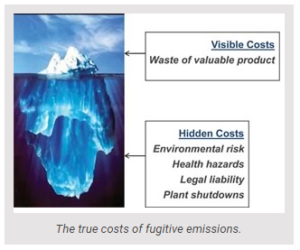Datasheet
What are Fugitive Emissions?
The Environmental Protection Agency (EPA) defines fugitive emissions as, “Those emissions which could not reasonably pass through a stack, chimney, vent, or other functionally-equivalent opening.” The term “fugitive” indicates emissions or leaks that are not intended, they are not captured by any equipment, and they are usually not detected through equipment monitors. New fugitive emissions monitoring and leak detection technologies including lidar (DIAL), portable imaging cameras, and portable VOC analyzers, are helping to discover large-scale leaks that were never detected before.
Two of the most dangerous fugitive emissions are methane (a powerful greenhouse gas 25 times stronger than carbon dioxide), and sulfur hexafluoride (SF6), the most potent greenhouse gas of them all at nearly 24,000 times the potency of CO2. The New York Times showed some of the positive results of the Department of Energy’s work to reduce high-impact fugitive emissions, but fugitive emissions from valves still release up to 52,000 tons/year of organic compounds into the atmosphere.
The Hidden Costs of Leaky Valves
According to a study at the University of British Columbia, leaky valves are responsible for approximately 60% of fugitive emissions from refineries. Another study in Forbes indicates that the oil and gas industry is losing approximately $30 billion/year due to fugitive emissions. The visible costs are the waste of valuable products and the high cost of EPA fines (as much as $10,000 per day per valve). The hidden costs include the vast environmental damage for greenhouse gases, the health hazards to employees and surrounding communities, plant shutdowns, and legal liabilities. The infographic below, from Valve World, shows the iceberg effect of the hidden costs of fugitive emissions from valves.


